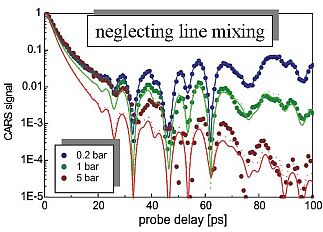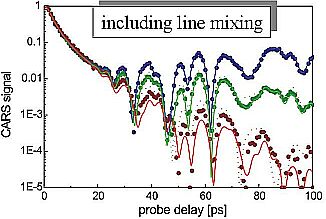Rotational energy transfer viewed in the time domain by femtosecond CARS
Femtosecond time-resolved coherent anti-Stokes Raman scattering (fs-CARS) provides a powerful tool for the investigation of collision-induced line broadening and mixing effects, e.g. for the validation of rotational energy transfer (RET) models. Whereas the linewidth determination with frequency resolved CARS is limited to the pressure range, where line mixing effects are negligible (typically <0.5 amagat for nitrogen), the time domain CARS signal becomes increasingly sensitive to the off-diagonal elements of the RET matrix at higher pressure (see figure below) [1]. The application of fs-CARS has very recently led to a new scaling law proposed for rotationally inelastic collisions, the angular momentum and energy corrected sudden approximation (AECS) [4,5].
-


Figure: Simulated CARS transients for N2 at 0.2, 1 and 5 bar neglecting and including line mixing effects and using the ECS-P model with the parameters of Ref [2] are compared to the experimental data (symbols).
[1] G. Knopp, P. Radi, M. Tulej, T. Gerber and P. Beaud, J. Chem. Phys. ,118 (2003) 8223.
[2] L. Bonamy, et al., J. Chem. Phys. 89 (1988) 5568.
[4] P. Beaud and G. Knopp, Chem. Phys. Lett. 371 (2003) 194.
[5] P. Beaud, T. Gerber, P. Radi, M. Tulej, and G. Knopp, Chem. Phys. Lett., 373 (2003) 251.